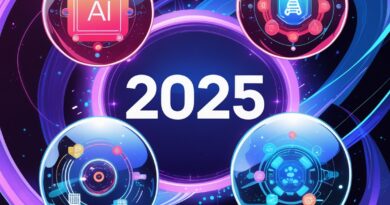Is Cal AI Calorie Tracker the Effortless Nutrition Coach You’ve Been Waiting For? 7 Things to Know
Introduction
Tired of the tedious tap-tap-tapping to log every single calorie? You’re not alone. For many, traditional calorie counting feels like a chore, making it tough to stick to health goals. But what if AI could do the heavy lifting? Enter the **Cal AI Calorie Tracker**, an app promising to simplify nutrition tracking with a snap of your camera. In a world increasingly reliant on smart solutions, the idea of an AI-powered diet assistant is incredibly appealing. Does this app live up to the hype? Can it genuinely make managing your diet effortless and accurate? This article dives deep into the Cal AI Calorie Tracker, exploring its features, potential benefits, and what you truly need to know before integrating it into your wellness journey. We’ll uncover how its AI technology aims to transform your approach to food logging and whether it’s the game-changer you need.
What Exactly is the Cal AI Calorie Tracker?
The Cal AI Calorie Tracker is a mobile application designed to take the guesswork and manual labor out of tracking your food intake. Developed by Viral Development LLC, its headline feature is the ability to analyze a photo of your meal and automatically estimate its caloric and macronutrient content. Instead of meticulously searching databases for every ingredient and guessing portion sizes, you simply snap a picture, and the app’s artificial intelligence (AI) gets to work.
- Beyond photo analysis, Cal AI offers a suite of tools common in modern nutrition apps, including:
- A barcode scanner for packaged foods.
- A searchable database of food items.
- Progress tracking for weight and other measurements.
- Personalized AI-driven suggestions.
- Logging capabilities for water intake and exercise.
The core promise is a streamlined, less time-consuming approach to understanding your dietary habits, aiming to make healthy eating more accessible and sustainable.
7 Key Aspects of the Cal AI Calorie Tracker Experience
As AI continues to reshape various aspects of our lives, from productivity to health, apps like the Cal AI Calorie Tracker are at the forefront of a nutritional revolution. But how does it fare in real-world use? Let’s explore seven critical aspects.

1. The Magic of AI Photo Logging: Snap, Analyze, Track!
This is Cal AI’s star attraction. The app allows you to take a photo of your meal, and its AI algorithms attempt to identify the foods and estimate portion sizes, then calculate calories, protein, carbs, and fats.
- The Upside: For those who find manual logging tedious, this is a potential game-changer. It’s quick and intuitive, especially for simple, visually distinct meals. The idea is to lower the barrier to entry for consistent tracking.
- Things to Consider: The accuracy of photo-based AI can vary. Complex dishes, hidden ingredients (like oils or sugars in sauces), or unconventional portion sizes can challenge even sophisticated AI. Some user reviews suggest that while convenient, the estimates might not always be spot-on, potentially being 50% off in some cases for less distinct items.
2. Beyond Photos: Barcode Scanning and Manual Entry
Recognizing that not every meal is a photogenic plate, Cal AI includes a barcode scanner for packaged foods. This is a standard and generally reliable feature in most tracking apps. Additionally, if the AI stumbles or you prefer more precision, you can manually search its food database and log items. This flexibility ensures you’re not solely reliant on the photo feature.
3. Personalized Plans and AI Suggestions
Upon setup, Cal AI asks lifestyle questions to help tailor a nutritional plan for you. As you use the app, it aims to provide AI-driven suggestions to keep you on track with your goals. This personalized approach is a growing trend in health apps, moving beyond one-size-fits-all recommendations. For more on how AI is revolutionizing diet management, check out insights from research institutions like MDPI on AI’s role in nutrition
4. Subscription Model for Full Power
While the app may offer basic functionalities for free, the core AI food scanning analysis and its detailed nutritional breakdown typically require a subscription. This is a common monetization strategy for apps offering advanced AI features. It’s crucial to understand what’s included in the free version versus the paid tiers before committing.
5. User Experience and Interface
Cal AI aims for a user-friendly experience, with the goal of making tracking feel less like a chore and more like an integrated part of your routine. The “snap and go” philosophy is central to this. However, some users have reported occasional glitches, like meals not logging correctly after being processed, which can detract from the “effortless” promise.
6. The Accuracy Debate: Convenience vs. Precision with Cal AI Calorie Tracker
This is perhaps the most critical consideration. While AI in food recognition is rapidly advancing, it’s not yet infallible. For individuals with strict dietary needs, medical conditions requiring precise nutrient tracking, or those in competitive athletic training, the potential for estimation errors with photo logging is a significant factor. For more casual users aiming for general awareness and healthier habits, the convenience might outweigh minor inaccuracies. The app itself notes that it does not offer medical advice and recommendations are suggestions.
7. Integration and Holistic Tracking
The app also allows users to log water intake and daily exercise. This positions Cal AI not just as a calorie counter but as a broader health and fitness companion. The ability to see food intake alongside hydration and activity levels provides a more holistic view of one’s lifestyle.
Is the Cal AI Calorie Tracker Right for You?
The Cal AI Calorie Tracker presents an exciting glimpse into the future of nutrition management. Its AI-powered photo logging offers undeniable convenience and can be a fantastic tool for individuals who:
- Despise manual calorie counting.
- Want a quick overview of their meal’s nutritional content.
- Are looking for general guidance and improved awareness of eating habits.
- Are motivated by tech-driven solutions.
However, if you require pinpoint accuracy for medical reasons, professional athletic pursuits, or simply prefer meticulous control over your data, you might find its current AI estimation capabilities need to be supplemented with manual checks or traditional logging methods.
As with any AI tool, it’s about understanding its strengths and limitations. The Cal AI Calorie Tracker could significantly reduce the friction of food logging for many, making the journey to healthier eating feel less daunting. Perhaps combining its AI convenience with a bit of your own knowledge is the balanced approach.
For those looking to enhance their digital well-being further, consider reading our related post: Top 5 Reasons Developers Are Switching to GitHub Copilot.
Conclusion
The Cal AI Calorie Tracker certainly makes a bold promise: to simplify nutrition tracking through the power of AI. Its photo-logging feature offers a significant step towards effortless meal management, appealing to anyone overwhelmed by traditional methods. While AI accuracy in food recognition is still evolving, the app provides a convenient way to become more mindful of your eating habits. If ease of use is your priority, Cal AI could be a valuable ally in your health journey.
What are your thoughts on AI-powered calorie trackers? Share your experiences or questions in the comments below!




